Central Participant Database/de: Difference between revisions
From LimeSurvey Manual
(Created page with "Dies filtert nicht nur die Teilnehmer in der Tabelle, sondern auch die in der Datenbank, die bis jetzt noch nicht geladen wurden. Es ist also eine umfangreiche Suche.") |
(Created page with "===Navigationsleiste===") |
||
| Line 159: | Line 159: | ||
Dies filtert nicht nur die Teilnehmer in der Tabelle, sondern auch die in der Datenbank, die bis jetzt noch nicht geladen wurden. Es ist also eine umfangreiche Suche. | Dies filtert nicht nur die Teilnehmer in der Tabelle, sondern auch die in der Datenbank, die bis jetzt noch nicht geladen wurden. Es ist also eine umfangreiche Suche. | ||
=== | ===Navigationsleiste=== | ||
To decrease load time of the grid we have used pagination which allows the you to see the first X number of entries ( chosen by the you) and then load more if required. To control this we have pagination control option in the navigator bar. | To decrease load time of the grid we have used pagination which allows the you to see the first X number of entries ( chosen by the you) and then load more if required. To control this we have pagination control option in the navigator bar. | ||
Revision as of 08:59, 14 April 2013
Einführung
Dieses neue Feature erlaubt es dem Administrator, die Teilnehmerinformationen in einer zentralen Datenbank zu speichern, die unabhängig der Tokentabelle ist. Die Hauptvorteile dieses Features sind:
- Die zentrale Datenbank kann als Backup dienen. Wenn zum Beispiel ein Benutzer eine neue Umfrage erstellt, muss er sich nicht damit herumschlagen, die Teilnehmer als CSV Datei abzuspeichern, und diese wieder in einer anderen Umfrage zu importieren.
- Der Benutzer muss die Teilnehmer nur einmal zur zentralen Datenbank hinzufügen und dann kann er mit diesen Daten soviele Umfragen erstellen, wie er will.
- Falls mehrere Benutzer dieselben Daten nutzen wollen, kann der Besitzer Benutzer teilen. Ausserdem kann er Zugriffsrechte auf geteilte Benutzer setzen.
Dazu kommen die erweiterte Attributkontrolle und einige weitere Features.
Die Teilnehmerpanel Management Werkzeuge

1 Start
2 Informationen ( Zusammenfassung der ZTD )
3 Zeige die Teilnehmertabelle
4 CSV Import
5 Alle Teilnehmer nach CSV exportieren
6 Blacklist Kontrolle
7 Globale Teilnehmereinstellungen
8 Attribut Kontrolle
9 Das "Teilen"-Panel
10 Das Übersichtspanel
Start
Das Teilnehmer-Panel ist ein seperates Panel in der LimeSurvey Administrator Werkzeugleiste, es führt also zurück zum Administrator Panel.
Information
Diese Anzeige zeigt die Statistiken der zentralen Teilnehmer Datenbank. Das gibt einen Überblick auf
1 Anzahl Teilnehmer in der zentralen Datenbank
2 Teilnehmer, die Sie hinzugefügt haben
3 Teilnehmer, die mit Ihnen geteilt wurden.
4 Teilnehmer, die Sie geteilt haben
5 Teilnehmer auf der Blacklist
6 Alle Eigenschaften der zentralen Datenbank
Zeige die Teilnehmertabelle
Hier kann man die Mehrheit aller Aktionen der zentralen Datenbank ausführen. Zum Beispiel: Teilnehmer hinzufügen, Teilnehmer löschen, Teilnehmer exportieren, zur Umfrage hinzufügen etc.
Hier ist ein Bildschirmfoto davon:

Die Erklärung des Bildschirmfotos:
1) jqGrid header
2 Teilnehmer hinzufügen
3 Teilnehmer löschen
4 Tabelle aktualisieren
5 Nach CSV exportieren ( Erweitert )
6 Erweiterte Suche
7 Navigationsleiste
8 Teilnehmer teilen
9 Zur Umfrage hinzufügen
10 Totale Anzahl Teilnehmer
11 Verstecke/Zeige Tabelle
12 Untertabelle
Teilnehmer hinzufügen
Mit Hilfe des Pluszeichens kann man neue Teilnehmer hinzufügen. Um den hinzugefügten Teilnehmer zu bearbeiten,
muss man auf den Teilnehmer doppelklicken und nach dem Bearbeiten Enter drücken. Wenn Veränderungen vorgenommen wurden, werden diese auf dem Server gespeichert.
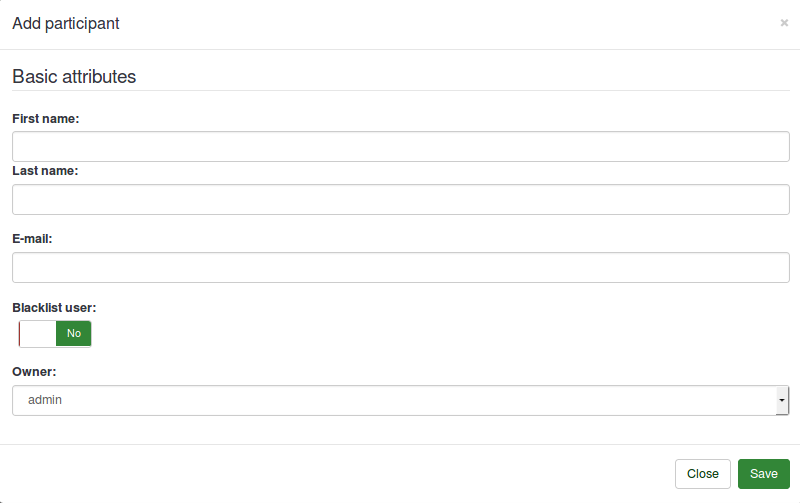
Teilnehmer löschen
Man kann einen Teilnehmer markieren, um ihn zu löschen oder einfach auswählen, dass alle Teilnehmer in der Tabelle gelöscht werden sollen. Es gibt drei verschiedene Bedingungen um Teilnehmer zu löschen.

Diese drei Bedingungen sind:
1 Teilnehmer nur aus dem zentralen Panel löschen
2 Lösche die Teilnehmer aus dem zentralen Panel und aus den Tokentabellen
3 Lösche die Teilnehmer aus dem zentralen Panel, aus den Tokentabellen und alle Antworten des Benutzers
Die erste Option löscht den Teilnehmer nur aus dem zentralen Panel, wenn der Teilnehmer in einer Tokentabelle ist, wird er nicht entfernt.
Die zweite Option löscht den Teilnehmer aus der zentralen und auch aus der Tokentabelle, aber seine Antworten bleiben erhalten.
Die dritte Option löscht alle Spuren des Teilnehmers, inklusive seinen Antworten. his responses.
In all the three options the links created for the purpose of maintaining history related to a particular participant are also deleted.
Aktualisiere Tabelle
Dies lädt die Tabellen neu vom Server herunter.
Nach CSV exportieren
Wenn man nach CSV exportieren will, öffnet sich eine Dialogbox, in der man die Spalten, die man exportieren will, markieren muss. Es gibt auch eine Option, um die Spalten zu filtern. Diese zeigt alle Spalten der zentralen Datenbank an. (sichtbar/nicht sichtbar)
Der CSV-Export kann unter zwei Umständen erfolgen:
1 Die Gefilterten exportieren
2 Alle exportieren
Es werden entweder alle oder nur die ausgewählten Teilnehmer exportiert, je nach ihrem Filterkriterium.
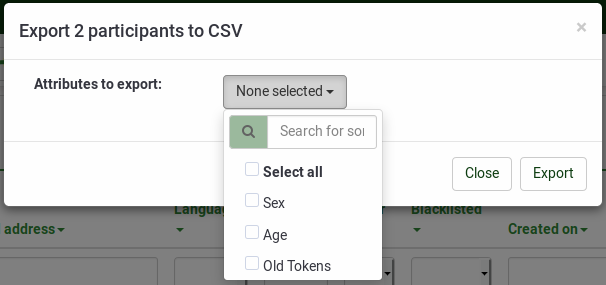
Die Datei wird unter dem Namen central_' das aktuelle Datum und die aktuelle Zeit'.csv gespeichert.
Erweiterte Suche
Das ist noch ein anderes Hauptfeatures des zentralen Panels. Es ist ein leistungsfähiges Feature, das nicht nur die Teilnehmerspalten durchsucht, sondern auch noch zusätzliche Spalten. (sichtbare und nicht sichtbare) Dieses Feature ist auch mit der Tabelle eingebaut.
Es gibt zwei Suchstufen, die man nutzen kann.
1 Einzelsuche
2 Kombinierte Suche
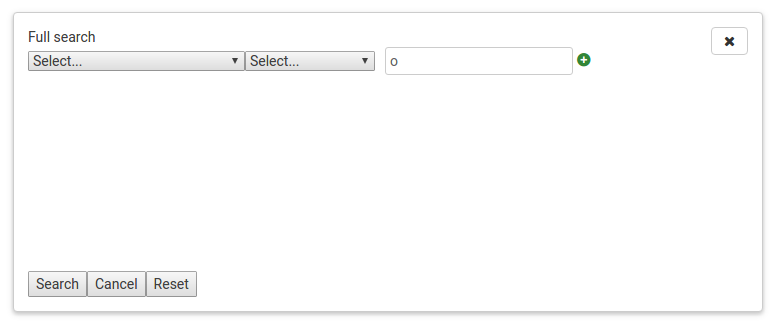
Es kann auch eine komplexe Bedingung benutzt werden, indem man ein Pluszeichen nach der vorherigen Bedingung setzt, oder man kann eine Bedingung entfernen, indem man vor die Bedingung ein Minuszeichen setzt.
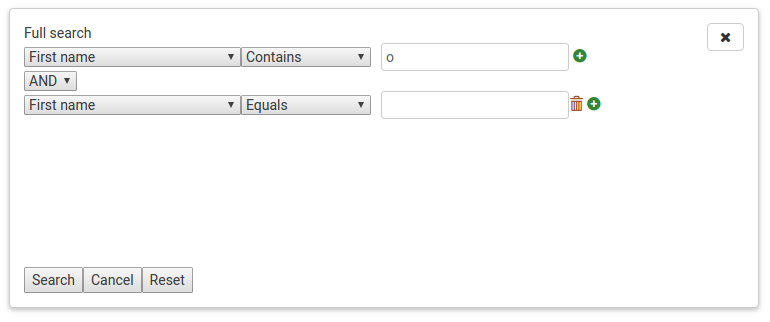
Dies filtert nicht nur die Teilnehmer in der Tabelle, sondern auch die in der Datenbank, die bis jetzt noch nicht geladen wurden. Es ist also eine umfangreiche Suche.
To decrease load time of the grid we have used pagination which allows the you to see the first X number of entries ( chosen by the you) and then load more if required. To control this we have pagination control option in the navigator bar.
Using the drop down menu you can select the number of entries to be loaded and with navigation buttons you can navigate sequentially and also use the text box to go to a certain page. Please note that the number of pages will reduce as you increase the number of entries that visible per page. Also the searching and sorting of grid are not dependent on the records visible in the grid at any particular time but are done on the whole central table.
This is another important feature of the Central Participants Database. You can share your participants with other users. You just have to select the participants you want to share and click on share. A modal box will open up which will allow you to select the user with whom you want to share.You can also set whether the user sharing your participant can edit those participants. If you set it no they will get an access denied error when trying to edit those shared entries.

Add to survey
Add to survey can be done at three levels :
1) all participants in current search
2) all participants
3) only the participant's that I have selected
As we know that the grid loads only the requested participants, thus ensuring minimum loading time for the user. So when you select a page on the grid (using multi-select or single select )that doesn't mean you have selected all the participants on the filtered participants from the database.So when exporting you are presented with the above mentioned three options which will be visible/invisible to you as per the present scenario.

For example if you have not selected any row and haven't done any search it will not show you any option and will only offer you to add all the participants in the grid and so on...
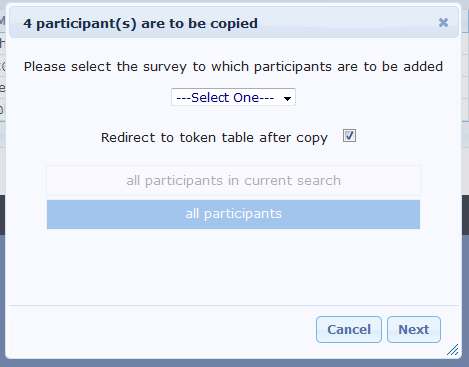
The title of the dialog box will show you the number of participants that are going to exported. Besides that, there is also a check box, that if checked, will take you to the token table of the survey to which you are adding the participants.
After clicking next you will be taken to the attribute map page.
The attribute map page has three columns and uses advance drag and drop functionality. The first column shows all the attributes that are present in the central table. The second column gives space to the user to create new attributes. The third column shows the attributes in the token table to which the user is adding participants. The user is free to choose to either create a new attribute in the token table to copy new values to or map the values from the attribute in the central table to the token table.
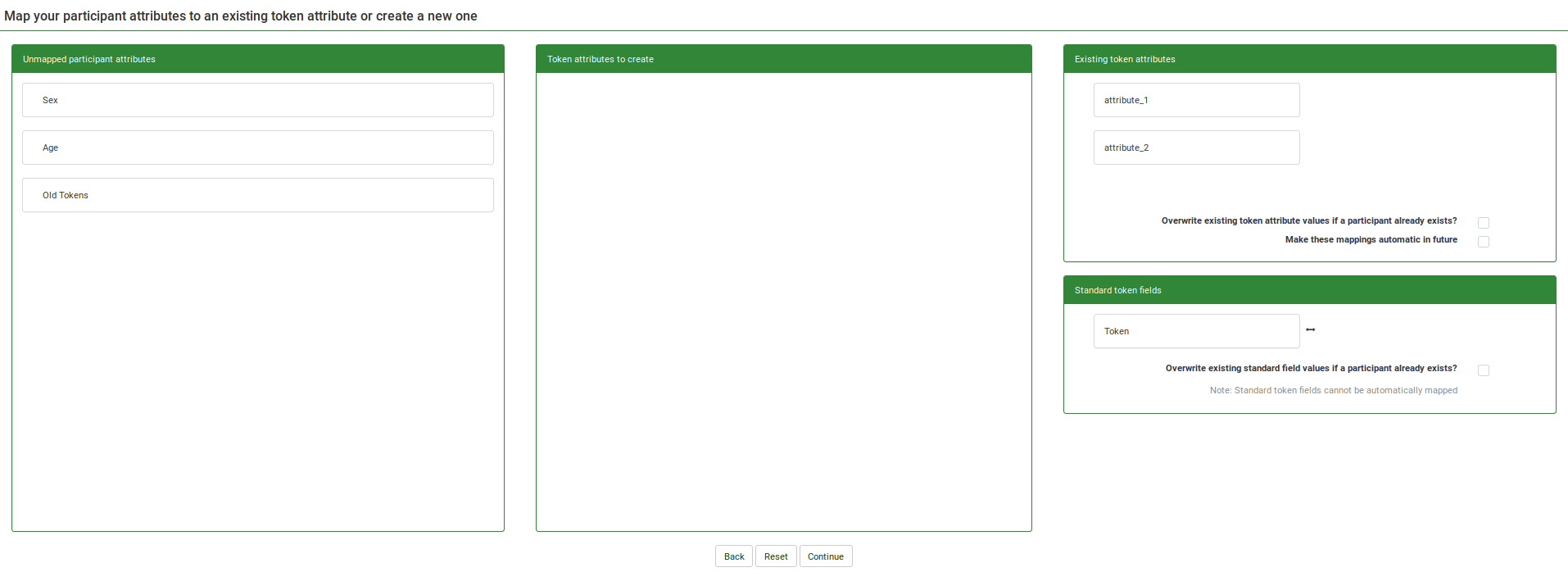
After you have mapped all the attributes, you can click on continue and after processing the participants a summary page will show up that will tell you how many participants were successfully copied, after which if you have asked for redirection you will be redirected to the token table table or else you will be redirected to the central grid.
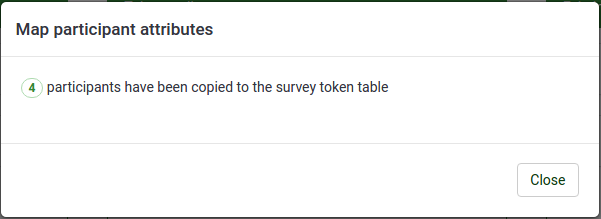
Total count
Number of participants out of total participants is displayed at the right of the navigator.
Hide/Show grid
Simply hide or show the grid.
Subgrid
For editing of attributes in the system we have implemented the concept subgrid in the main grid that shows all the attributes in the system and also allows you to edit them. The main grid shows only the visible attributes, the rest of the attributes are available here and only fetched when required. The subgrid as the main grid allows inline editing of attributes and also sorting. It also shows the links to the surveys to which the participant is added to. In case the participant is not added to atleast one survey, this subgrid is not diplayed. When you expand the subgrid, all of the attributes in the system show up, but that doesn't means all the attribute values for that participant are saved in the database. Only when you add some value, that attribute value is saved for that particular participant.
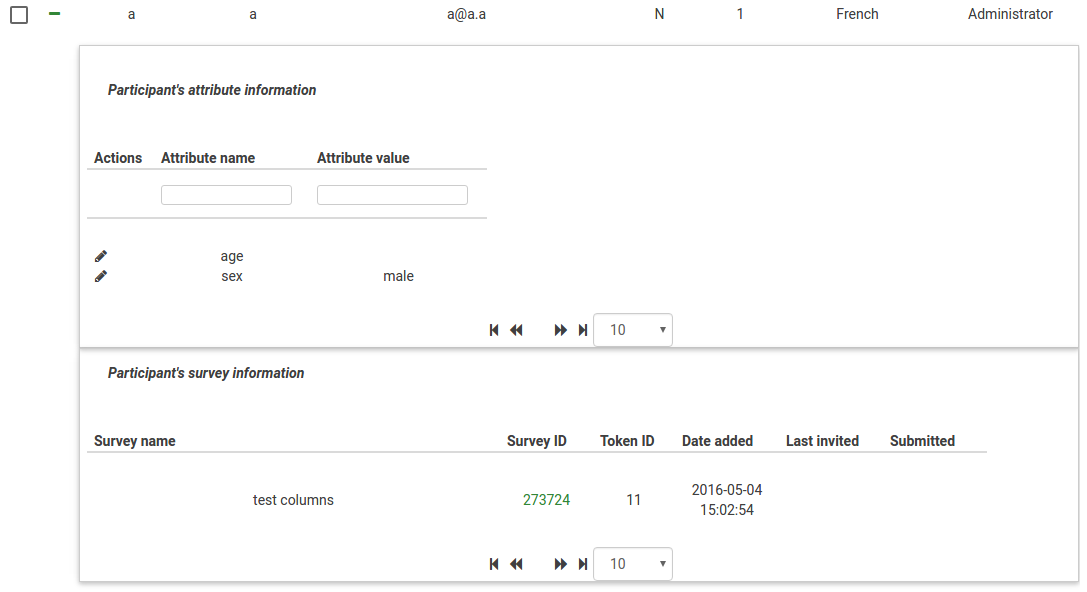
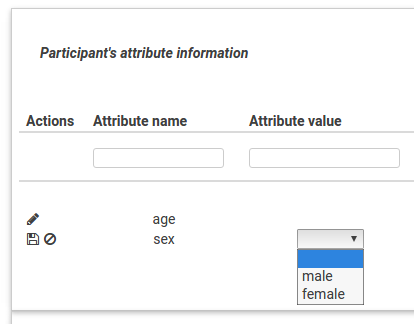
Import from CSV
This supports files with only *.csv extension. The rest of the settings are similar with what we have for "import CSV" under tokens. As in "add to survey" option we also have a drag and drop control over the attribute here. This feature scans all the headings in the CSV and shows them . You can map the attribute to an already existing central attribute or choose to create a new one.
Steps to import
1) Select a file to import and specify associated settings.
2) Map the attributes in the CSV to those in the central table or create a new attribute. New attributes created will be of text box type but can be changed later.

In the example screenshot I have created a new attribute age and mapped sex with the attribute in the central table.
3) Wait for it to process and show the summary.
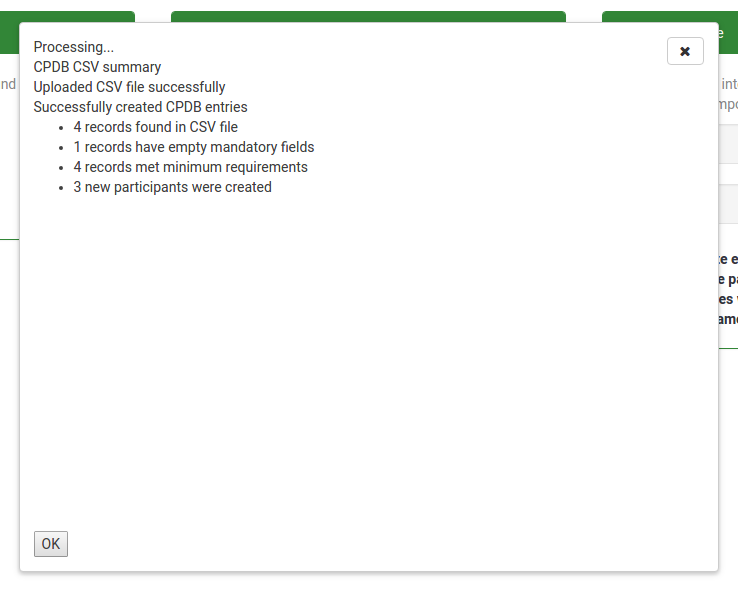
Clicking ok will redirect you to the display participants screen showing the newly imported participants.
Export all
This feature is for simplicity of the user. The user can click on it and can download all the participants that he has access to.
Global participant’s settings
For security purposes the editing of user id is restricted, as it's the user id associated with the participant which decides the ownership of the participant. For this there setting in the main CPDB panel which can be changed only by the super administrator. If the setting is set to yes, you can edit the user name field in the display grid.

When you double click on the row, you can see a drop down in the owner name field where the list of all users in the system are listed and you choose which one to give participant rights to.

Attribute control
This is yet another advance feature of the Central Participants Database. The attribute control in the token system allows to add only the attribute of text type, which reduces complexity, but when you have to add a large number of attribute values, it becomes very tiring to type the exact same value, for example 'male', repeatedly. To overcome this problem we have introduced three different attribute types :
1) Drop down
2) Text box
3) Date picker
You can choose either of the attribute types and associated UI will be presented to you while editing. For drop down , you will need to add possible values. Also, the attribute control has multilingual support.

As you can see there are already two existing attributes in the system. You can set their visibility right here by using the check box. The visibility will determine as to whether the attributes should be visible in the main grid or not.
For adding a new attribute you just have to click on the plus sign and another row will pop up allowing you to put in basic details and saving the attribute.
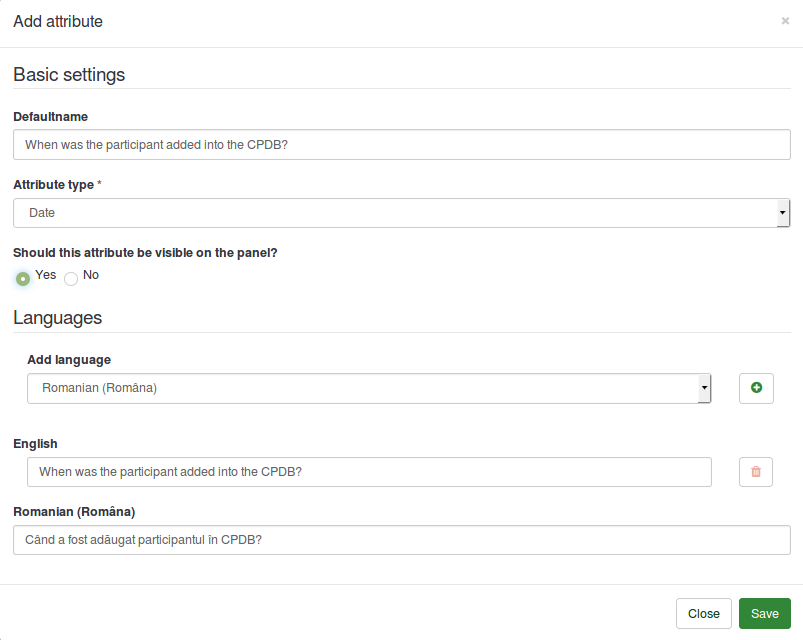
You can save the attribute by using the save button or by pressing enter after entering the attribute name.
For deleting an attribute in the system just click on the delete button next to the edit button. Clicking the delete button will not only delete the attribute but also the associated values.
For advanced editing, such as adding of drop down values and adding multilingual languages, you need to click on the edit button. On clicking the edit button you will see something like this.
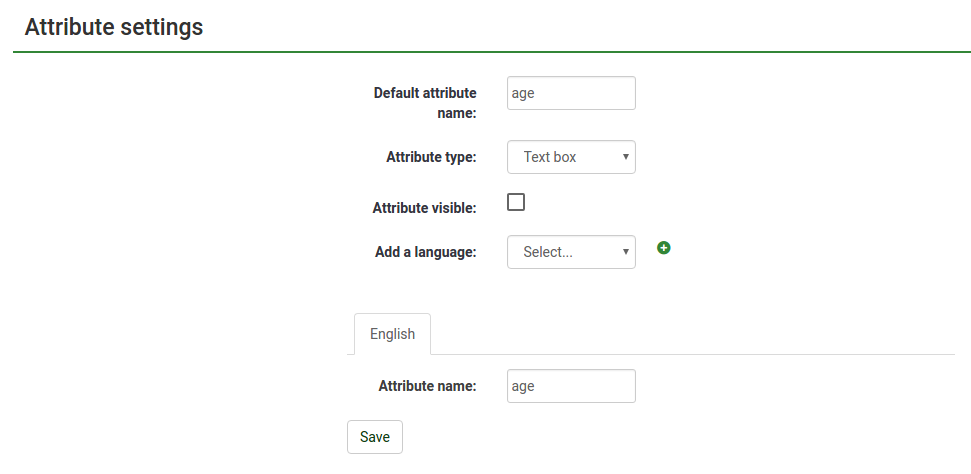
For adding a new language you can click on the plus sign and a new tab will pop up and you can add the attribute name in that language there.
You can also add drop down values by selecting the drop down attribute type.

You can edit the possible values of the drop down by clicking on the edit button or clicking on the value itself as it supports inline edit similar to what we have in the grid. Delete button is for deleting the specific value.
As you can see in the screenshots, the entire attribute properties can be edited here.
The share panel shows all the information related to the shared participant. Please note that this panel shows only the shared participants owned by that particular user.

This panel shows values like
1) First Name
2) Last Name
3) E-Mail
4) Shared With
5) Owner
6) Date Added
7) Can Edit
All this information is for viewing/sorting purposes only and only the "Can Edit" field is editable for the user. The can edit field as explained earlier determines whether to allow the shared participant to be editable by the sharer or not.Just clicking on the check box will make an AJAX call and save the changes on the server.
Panel summary
Panel summary is same as information, only it is loaded when the CPDB panel is opened and it can be accessed again by using the information icon in the toolbar.
Additional information
Additional (technical) information is available at Central participants database (User panel)